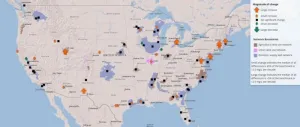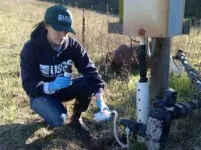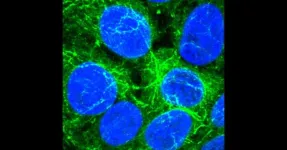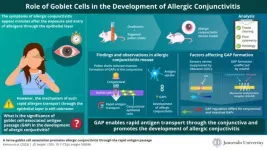(Press-News.org) 17 October 2023
The Geological Society of America
Release No. 23-41
Contact: Justin Samuel
+1-303-357-1026
jsamuel@geosociety.org
For Immediate Release
Contributed by Sarah Derouin
Pittsburgh, Pa., USA: Scientists from the U.S. Geological Survey (USGS) have been monitoring groundwater quality in wells across the country for more than three decades, looking for harmful chemicals or residual substances that may cause harm to ecosystems or humans. In all, they have measured up to 500 chemical constituents, including major ions, metals, pesticides, volatile organic compounds, fertilizers, and radionuclides.
Of these constituents, there have been significant increases of Na and Cl ions and dissolved solids—all related to salinity. Details and trends found in the multidecadal study will be presented at the Geological Society of America’s GSA Connects 2023 meeting on Wednesday, 18 October.
The study is currently part of the National Water Quality Network, continuing work that began in 1992 as part of the National Water Quality Assessment Project. “The original goal was to evaluate the status of water quality in the nation, including groundwater, surface water, and ecological health,” says Bruce Lindsey, a hydrologist with USGS. Over time, they focused on certain constituents that may have lingering detrimental effects.
The researchers sampled wells within three different network types: domestic areas, urban areas, and agricultural areas. Domestic wells, or private wells that are not regulated by the Environmental Protection Agency or a local municipality, represented medium depth aquifers and drinking water. Urban and agricultural wells were shallower, usually around 30 to 50 ft deep. “The purpose of [sampling] those were to understand the status and trends in the very shallowest water levels,” explains Lindsey. Those shallow wells acted as “sort of a sentinel of what might be moving deeper into the aquifer, so to speak.”
The team identified 82 networks, each with 20 to 30 wells, and identified 28 constituents to track that had levels of concern. Water was sampled every 10 years to track changes in chemical concentrations. These constituents and sampling results can be seen on the USGS’s interactive groundwater map, which shows decadal changes.
“If we look at all 28 constituents across all 82 networks, dissolved solids, chloride, and sodium had statistically significant increases more frequently than any other constituents that we have on our list,” says Lindsey. “If you look at the map, you’ll see patterns right away that jump out.”
One of these spots is the Northeastern and Upper Midwest regions, “particularly around urban areas where there’s cold weather and a lot of road salt,” says Lindsey. “We obtained data on road salt application and found correlations between these increases in chloride and sodium and dissolved solids with the road salt application rates.”
But another region also had elevated levels of Cl, Na, and dissolved solids: the arid regions of the country, especially in the southwest. These regions naturally have high salinity in the soil to begin with, but irrigation complicates the issue.
“When irrigating agriculture in arid regions, you get a lot of evaporation,” Lindsey explains. “So if the salinity of the irrigation water is relatively low, but a large percentage of it evaporates, [salinity levels] can become high.”
These rising levels of Na, Cl, and dissolved solids can cause multiple problems, starting with the environment. Many streams are fed by groundwater, and higher concentrations of chloride in the water can knock out the natural balance that aquatic life is used to. “[Rising levels] is something that can take 20, 30, 40 years to develop … which means that it can also take that long to recover if management of the sources of salinity changes,” says Lindsey.
Dissolved salt ions can also pose problems for infrastructure. As the salinity of groundwater increases, corrosivity can become an issue. Corrosive groundwater, if untreated, can dissolve lead and other metals from pipes and other components present in household plumbing.
Lastly, Lindsey and his colleagues have also discovered a unique issue related to rising salinity with implications for human health. In a sandy aquifer in southern New Jersey, they found that a mixture of low pH water and high salinity groundwater has mobilized the radium— a radioactive element which is harmful to humans.
“It goes back to road salt,” he says. “Road salt is increasing, causing sodium and chloride to increase, which is causing radium to increase.”
Lindsey notes that there seems to be increased awareness of the environmental effects of road salt, with trucks spreading less salt or municipalities switching to a lower-concentration brine. And while dead grass near salted roadways is a clear hint at an oversalting problem, Lindsey hopes that research like this will highlight other cascading impacts of increasing salinity in groundwater. “The fact that there may be streams that are not able to sustain aquatic life, or that your pipes might start corroding, or this other more rare issue where there's radium, shows there are other negative aspects [to rising groundwater salinity].”
Increasing salinization of groundwater in the United States
Contact: Bruce Lindsey, blindsey@usgs.gov
262: T96. Salinization of Freshwater
Wed., 18 Oct. 2023, 1:35–1:55 p.m.
The Geological Society of America (https://www.geosociety.org) unites a diverse community of geoscientists in a common purpose to study the mysteries of our planet (and beyond) and share scientific findings. Members and friends around the world, from academia, government, and industry, participate in GSA meetings, publications, and programs at all career levels, to foster professional excellence. GSA values and supports inclusion through cooperative research, public dialogue on earth issues, science education, and the application of geoscience in the service of humankind.
###
END
U.S. groundwater is getting saltier—what that means for infrastructure, ecosystems, and human health
New research presented at GSA Connects 2023
2023-10-17
ELSE PRESS RELEASES FROM THIS DATE:
Pathogen that plagues food processing plants eradicated by blue light
2023-10-17
Washington, D.C. – Blue light kills both dried cells and biofilms of the pathogen Listeria monocytogenes, a frequent contaminant of food processing facilities. Demise of L. monocytogenes occurred quickest when cells or biofilms were placed on polystyrene, a widely used, transparent form of plastic. The research is published in Applied and Environmental Microbiology, a journal of the American Society for Microbiology.
“These results contribute to advancing our understanding of the potential of blue light to treat inert surfaces contaminated with L. monocytogenes,” said corresponding author ...
Public health interventions prevented transmission within BU most SARS-CoV-2 cases
2023-10-17
(Boston)— SARS-CoV-2, the causative agent of COVID-19, began impacting the U.S. in March 2020 with many schools and universities shifting to remote education by early April 2020 in response to the public health emergency. Despite public health interventions (increased ventilation, masking policies, surveillance testing, contact tracing of confirmed cases and quarantine procedures for infected students, faculty and staff) there were still concerns that institutes of higher education would be a hotbed of transmission, including transmission from students into surrounding communities.
But, were these fears warranted?
A ...
CastleVax Inc. receives BARDA project NextGen award valued at up to $338 million to advance intranasal NDV-based COVID-19 booster vaccine into phase 2b clinical efficacy testing
2023-10-17
CastleVax, a clinical stage vaccine platform company, has received a Project NexGen award valued at up to $338 million from the Biomedical Advanced Research and Development Authority (BARDA), part of the Administration for Strategic Preparedness and Response (ASPR) in the U.S. Department of Health and Human Services (HHS), to support the development of a next-generation, booster vaccine to protect against COVID-19 for years to come. The initial phase of the award provides approximately $8.5 million to plan a Phase 2b clinical trial that would compare CastleVax’s vaccine to currently ...
New cancer therapy target stops tumor cells from sharing resources
2023-10-17
Researchers at University of California San Diego have discovered a process in which liver cells share molecules via vesicle exchange in order to multiply under conditions that would ordinarily suppress cell proliferation. They also found evidence that this process occurs in various types of cancer cells, paving the way for a new approach to tackling treatment resistance in cancer. The findings were published on October 17, 2023 in eLife.
“Understanding cell proliferation is a fundamental issue in both cancer research and biomedical science as a whole,” said Gen-Sheng Feng, PhD, a professor of pathology at UC San Diego School of Medicine and of molecular biology ...
International team reveals source of largest ever Mars quake
2023-10-17
A global team of scientists have announced the results of an unprecedented collaboration to search for the source of the largest ever seismic event recorded on Mars. The study, led by the University of Oxford, rules out a meteorite impact, suggesting instead that the quake was the result of enormous tectonic forces within Mars’ crust.
The quake, which had a magnitude of 4.7 and caused vibrations to reverberate through the planet for at least six hours, was recorded by NASA’s InSight lander on May 4 2022. ...
The dark side of the American lawn
2023-10-17
The American residential lawn is, for many, an iconic landscape and about half of homeowners in the US use fertilizer to keep their yards green and lush. Some proportion of the nitrogen in this fertilizer enters the broader environment, with negative consequences including algal blooms and deoxygenated waters. Peter Groffman and colleagues studied residential landscapes in the Baltimore, Maryland metropolitan area, which drains to the Chesapeake Bay, seeking to identify locations (hotspots) or times (hot moments) with disproportionately high rates of nitrogen export. The authors went to lawns in exurban, ...
New study sheds light on the developmental mechanism of allergic conjunctivitis
2023-10-17
When it comes to eye allergies, the transition from allergen contact to bothersome symptoms has always been quick, appearing within a span of a few minutes. The initial stage of allergic conjunctivitis involves the penetration of allergen through the epithelial cell layer (cells covering the outer surface of the body). However, the exact mechanism underlying the rapid allergen transfer has remained a mystery so far.
Fortunately, in a new ground-breaking study published in the journal JCI Insight on October 11, 2023, researchers from Juntendo ...
Western University researchers reveal link between Alzheimer’s and sex hormones
2023-10-17
LONDON, ON., CA:
Alzheimer’s disease disproportionately affects women, who represent about two-thirds of those diagnosed with the late-onset type of the disease.
Previous research has shown Alzheimer’s is also more severe and progresses more rapidly in women, and women with Alzheimer’s experience a steeper cognitive decline – loss of memory, attention, and the ability to communicate and make decisions – compared to men with the disease.
The biological bases for these differences between men and women with Alzheimer’s disease are not well understood. ...
How to help save plants from extinction
2023-10-17
Now is the time to identify the conditions that cause plants to die. Doing so will allow us to better protect plants by choosing conservation targets more strategically, UC Riverside botanists argue in a new paper.
Published in the Oxford Academic journal Conservation Physiology, the paper demonstrates how scientists can learn the limits past which plants’ vital functions shut down, and makes the case that not doing so is a mistake in this era of increasing drought and wildfires.
“We can measure the amount of water loss plants ...
Kennedy Krieger receives $5 million grant to expand reach of its pediatric post-COVID-19 clinic and support school students
2023-10-17
BALTIMORE, October 17, 2023—Researchers at Kennedy Krieger Institute have received a $5 million grant from the U.S. Department of Health and Human Services (HHS), through the Agency for Healthcare Research and Quality (AHRQ), to expand access to comprehensive care for children and adolescents with long COVID-19, particularly among underserved populations.
During the five-year project, researchers at the Pediatric Post-COVID-19 Rehabilitation Clinic will receive up to $1 million annually to expand and strengthen its integrative services in Baltimore and the overall mid-Atlantic ...
LAST 30 PRESS RELEASES:
New fossil study illuminates on the evolutionary success of frogs
Patient-specific human liver model to understand disease mechanisms
Confused by the doctor's questionnaire? U of A study suggests it's common
How do brains stay stable, and when might a dose of flexibility be helpful?
mRNA revitalizes aging immune systems—the liver as a fountain of youth
Rural-urban differences in the prevalence of chronic pain among adult cancer survivors
Food insecurity, burnout, and social isolation among resident and fellow physicians
How do spinal cord injuries heal?
Detailed cell map unlocks secrets of how reproductive organs form
Large language models unleash AI’s potential for autonomous and explainable materials discovery
Gut bacteria have evolved rapidly to digest starches in ultra-processed foods
New risk score helps predict pancreatic cancer recurrence
New evidence challenges understanding of Parkinson’s disease
A new study reveals how embryos and the uterus “talk” during implantation
Cedars-Sinai reports heart attacks, general illness spiked after LA fires
PolyU develops ultra-stable, mucus-inspired hydrogel to boost gastrointestinal wound healing
Flour choice shapes sourdough microbial communities
Can a retinal implant reverse macular degeneration?
Feeding fungi plant remnants produces tasty protein to fortify vegan, vegetarian diets
New tech reduces false positives from breast ultrasounds
Drone-mounted lab monitors fertilizer runoff in real time
Short, light-intensity exercise boosts executive function and elevates mood in children
Jeonbuk National University researchers reveal new interface engineering strategy for efficient and stable back-contact solar cells
Tyrosinase drives hydroquinone-induced exogenous ochronosis: not HGD inhibition
UMass Amherst chemists develop unique tool for studying RNA
Disappointment alters brain chemistry and behavior
A built-in odometer: new study reveals how the brain measures distance
Stress-related brain signals drive risk of cardiovascular disease in people with depression and anxiety
New details on role of fat transport molecules in Alzheimer’s onset
Study illuminates how an antiviral defense mechanism may lead to Alzheimer’s disease
[Press-News.org] U.S. groundwater is getting saltier—what that means for infrastructure, ecosystems, and human healthNew research presented at GSA Connects 2023





